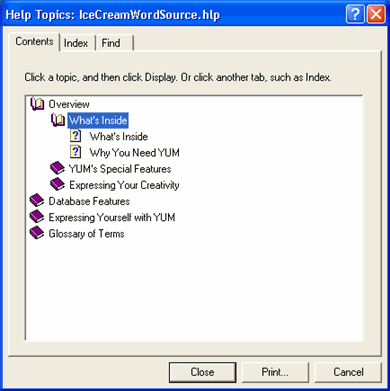In 1995, Microsoft released WinHelp 4.0 as the online Help standard for desktop applications for the Windows operating system. It offered a sleek new look (for its day), as well as a host of navigation and access features. While WinHelp’s grip on the Help market is diminishing, its feature set provides a baseline for comparison among all the available Help targets.
WinHelp 4.0 introduced a model where major navigational components reside separately from content. The contents, index, and search functions display in a separate, somewhat annoying modal dialog box, the Help Topics dialog box. The major weakness inherent in this display model is the lack of ease in switching back and forth between the Help Topics dialog box and the WinHelp viewer—between navigation and content.
The Help Topics dialog box supports three standard tabs: Contents, Index, and Find (full-text search).
The Contents tab replaces the Contents topic in earlier WinHelp systems, and it displays the Help contents in an expandable tree format, containing books and pages. Books divide the content into a logical structure, while pages link to specific topics.

WinHelp 4.0 also introduced true second-level keyword entries. Help authors gained the functionality required to create a proper index two levels deep—an index that more closely resembles a back-of-the-book index.

The Find tab supports full-text search capability. With no stop list to filter noise, the full-text search is a less powerful search function than a well-constructed Index. In addition, the full-text search shows every occurrence of a word, it is not selective; and it is literal. It only shows the words that exist. In order to find something, you must know what words the author used – not what you might use.
